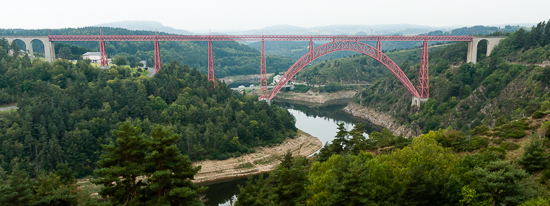Following on from my last post, a short distance south from St Flour - Chaude Aigues on the ligne des Causses is the Garabit Viaduct that spans the Truyère River.
 The Garabit Viaduct, 14/9/07
The Garabit Viaduct, 14/9/07
Constructed between 1882 and 1884 by Gustave Eiffel and opened in 1885 the viaduct was, when built, the highest in the world at 122m (400ft). With a length of 565m (1,853ft) and a principal arch of 165m (541ft) it is a very impressive sight, one that can be enjoyed from a rest stop (Aire de Repos de Garabit) alongside La Méridienne, the A75 autoroute linking Clermont-Ferrand and Béziers.
After an overnight stay in St Flour breakfast was a picnic overlooking the viaduct (in very dull weather) and we were just about to continue on our journey when a train rumbled into view with a pair of FRET-liveried SNCF class BB 67400 diesels in charge, 467467 and 467448.
 SNCF class BB 67400s 467467 and 467448 head north across the Garabit Viaduct, 14/9/07
SNCF class BB 67400s 467467 and 467448 head north across the Garabit Viaduct, 14/9/07
The train consisted of empty steel wagons returning to Clermont-Ferrand from the Arcelor Mittal plant at Saint-Chély-d'Apcher in the Languedoc-Roussillon Region, the loaded trains, even double-headed by two 2,367hp locos, run south in two portions due to the severe gradients on the line.

One fact that always pops up whenever the Garabit Viaduct is mentioned (and I'm not going to miss the opportunity to mention it myself) is that it was used in the 1976 film The Cassandra Crossing that starred Sophia Loren, Richard Harris and Burt Lancaster but was universally panned by critics and audiences alike.















